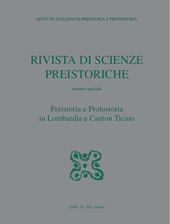La pianura fra Ticino e Sesia nella prima età del Ferro
P. 595-608
This paper focuses on the archaeological aspects of the plain between the Ticino and Sesia Rivers from the Final Bronze Age to the Early Iron Age. In this area, which is the western boundary of the Golasecca culture, the population dynamics are interesting in relation both to the role of Castelletto Ticino – Golasecca - Sesto Calende and to the rest of Italian peninsula. At the end of the Final Bronze Age many settlements were abandoned, and the territory appears depopulated until the 7th century BC.
From the late 7th century BC, however, archaeological data increase and show the beginning of a new developmental trend, in coincidence with the flourishing of Castelletto Ticino – Golasecca - Sesto Calende: some isolated artefacts show the opening of long-distance routes along the rivers. During the 6th century BC two main settlements arose: GropelloSanto Spirito and Proh-Briona, which probably played a strategic role along the way to Castelletto Ticino – Golasecca – Sesto Calende and show the importance of controlling the plain. During the 5th century BC, when Castelletto Ticino – Golasecca - Sesto Calende declined and disappeared, the territory was still inhabited: this territorial system will change again during the late 5th century BC. [Publisher's text]
-
Articles from the same issue (available individually)
-
Information
DOI: 10.32097/1197
ISSN: 2282-457X


